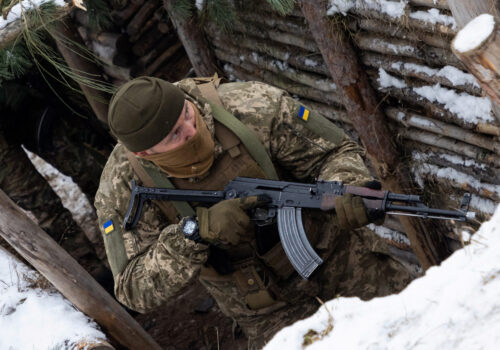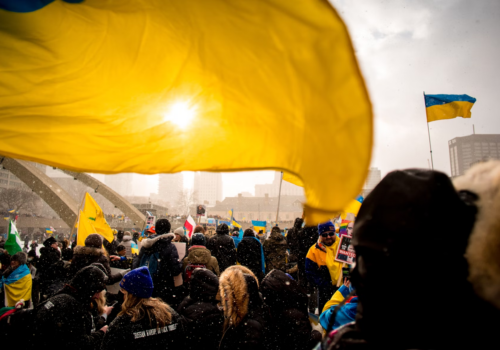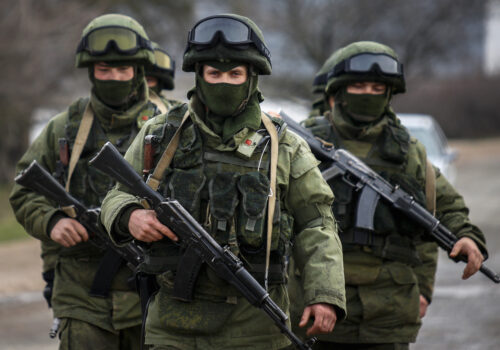The EU needs a more comprehensive plan to aid Ukraine
As Russia’s illegal full-scale invasion of Ukraine stretches into its third year, the clouds on Brussels’ bleak winter horizon are more foreboding than usual. The culmination of Kyiv’s summer 2023 counteroffensive, with very little change in the lines of control, illustrates the reality that the fight for a free and independent Ukraine will be a protracted conflict. In Washington, additional aid to Ukraine remains mired in Congress. One bright spot, however, was the European Union’s (EU) decision on February 1 to approve an additional fifty-four billion dollars in support to Ukraine through 2027. This is a good start, but the EU can and must do more.
The EU needs a comprehensive plan for its beleaguered neighbor. In addition to the current aid package, and along with discussions about Ukraine’s EU accession, which will take a decade or more, the EU needs to implement a three-pronged strategy. The EU must ramp up its economic recovery program to get private and public sector investment to rebuild Ukraine. It should develop a longer basic military training course and a staff officer course to help the Ukrainian military effect large-scale maneuvers, which Ukrainian forces cannot yet do. And it should build out pan-European defense procurement for Ukraine.
The United States must continue to play a critical role in supporting Ukraine. It can do this, for example, by passing the sixty-one billion dollar spending package for Ukraine and then working with European allies to implement a better strategy to continue support. But for the Biden administration, the task over the next year should also be to Europeanize the war in Ukraine, with the EU and the United Kingdom becoming Kyiv’s leading sources of military aid (in addition to overall aid), with the United States in a supporting role.
Ramp up EU members’ defense production
First, European states must move themselves onto an industrial war footing—which they still have not done. The EU has made ambitious promises to deliver armaments, but it has not yet delivered on these promises. The EU pledged one million 155-millimeter shells to Ukraine, for example, but EU members have thus far sent only around three hundred thousand from their own stockpiles and they have little capacity to get more quickly. European states should also stop prevaricating on key systems, such as long-range Taurus missiles, which are critical to any effort to compel Russia to the negotiating table.
To facilitate long-term defense production and planning, European states must collectively approach industry to lay out bulk annual orders and insist that Ukraine is prioritized for delivery. European states should also select a set number of current systems and order those specific systems rather than supplying a broad array of systems, which has led to a polyglot arsenal that brings as many challenges as it does benefits.
Right now, Ukraine gets a range of systems: some old and some new. This made sense as the older systems were readily available and donations of Warsaw Pact equipment by new NATO allies, such as Poland and the Czech Republic, facilitated military transformation within the Alliance and helped Ukraine. But as these older systems lack enough spare parts and as they wear out, they need to be replaced with Western military technology. New systems, often awarded on a national basis, complicate Ukraine’s ability to utilize them effectively. Offering select new systems will make training, as well as replacement part procurement, more logical and efficient. The EU and the United States should select a smaller range of systems to donate to Ukraine going forward. For example, all tanks could be Leopards, all fighter aircraft could be F-16s, and howitzers should be limited to three or four systems to make long-term sustainability more practicable.
Enhance training for Ukrainian troops
Just as defense procurement and supply must be systematized, so too must training. New recruits to the Ukrainian military receive five weeks of basic training—this is woefully insufficient. During World War II, new British recruits got twenty-four weeks. Basic combat training in the United States is ten weeks, in the French Foreign Legion it is twelve, and for UK infantry it is twenty-eight weeks. The challenge for Ukraine is how to build a military while still fighting a war. As the campaign to keep Ukraine free enters its third year, Kyiv must mobilize a broader swathe of society and it must do so quickly, so that these recruits can receive better basic training.
Initial recruits should get a ten-week basic course and then be cycled into combat. European states should create a longer, fifteen-week course and run two parallel courses, cycling out experienced soldiers for more advanced courses. Given Ukrainian constraints on manpower, it is imperative that new soldiers get the best training possible to increase their chances of success on the battlefield. Equipment is far easier to replace than manpower, and Ukraine has a far smaller pool of potential soldiers than Russia. It must fight smarter with better-trained troops.
The second task will be to create two sets of officer courses—a shorter twenty-week basic officers’ course and a longer thirty-week staff officer course. This could be modeled on the US Maneuver Captain’s Career course. This can be done while cycling between groups to allow as many soldiers to stay in the field as possible, while new officers get first-round training and more experienced officers receive advanced training.
Officer training is critical, as Ukraine lacks staff officer capacity, which was evident over Ukraine’s summer 2023 counteroffensive. Having eliminated the divisional level decades ago for cost savings, Ukraine’s officer corps cannot conduct large-scale maneuver warfare—it simply does not have the command-and-control capacity. This means that even if the size of the enlisted force doubled, Ukraine would be unable to effectively employ them in large-scale offensive operations. With the lines of control frozen and Ukraine in a defensive orientation, the task needs to be to build up a larger and more effective fighting force over the next twelve to eighteen months, a process which should then continue indefinitely.
Revitalize Ukraine’s economy
The third and final piece of the puzzle is rebooting Ukraine’s economy, which is currently on life support. Russia’s invasion cut Ukraine’s gross domestic product by around 30 percent in the first year of the war. Kyiv’s 2023 budget deficit was thirty-eight billion dollars, some thirty-one billion of which was offset by international assistance. The World Bank estimates that rebuilding Ukraine over the next decade will cost nearly five hundred billion dollars, which will need to come in the form of grants, loans, and private investment. Here, the EU is doing well via the bloc’s recently approved “Ukraine Facility,” which allows it to provide more than fifty billion euros in grants and loans to Ukraine over four years. This is a good start, but it is not enough.
The EU, the United Kingdom, and the United States should work to pass the legislation required to seize frozen Russian assets, which can then be used to rebuild Ukraine. Using Russian funds as collateral is not sufficient. Belgium’s Euroclear has around $180 billion in Russian reserves on the books. The October 2023 Group of Seven (G7) communiqué included language that such options should be explored, but action, not merely exploration is necessary.
Right now, the legal frameworks simply do not exist to seize the funds. The challenge here is getting the laws in place and then keeping financial markets stable—no easy task given the politics in Europe. But it is worth pursuing options to seize the funds, and once seized, the funds should be placed into an international trusteeship that can reinvest the funds to generate annual income for Ukraine, and where necessary, draw down on some of the principal reserves.
EU member states also should support private sector investment into Ukraine, given the enormous risk facing anyone attempting to run a business in the country. This can be achieved via a mix of tax breaks for companies willing to build and operate facilities in Ukraine, as well as through a special bloc insurance scheme to offset risk. Industrial efforts should focus on the defense industry, but wider multi-sectoral investment is necessary. In turn, Ukraine needs to reciprocate. As the EU has made clear, Ukraine needs serious, deep reform to clean up the court system and ensure the independence of supervisory boards at state-owned enterprises. Kyiv must continue to support transparent privatization efforts—all of which will contribute to a more level playing field for international investors.
Rebooting the economy, prioritizing defense industrial production, and systematizing longer military training will send a strong signal to Russia that the EU is prepared to support Ukraine in a long war. This will make it more likely that Russia will consider negotiations to settle the war, as well as increase Ukraine’s ability to defend itself, and perhaps launch a more successful offensive. Right now, neither Ukraine’s posture nor Western assurances look credible to Russian President Vladimir Putin. Compelling him to change course requires a different approach that Ukraine and its partners must begin to implement immediately.
The role of the United States
The White House has a critical role to play in establishing a more systematized approach to assisting Ukraine. Washington, because of its commitment to Europe via NATO, can focus minds and corral allies in a way that EU leaders cannot. Indeed, much action is required at the national level, where certain legal privileges remain in Europe, rather than at the EU level.
Continued methodical and deliberate engagement across Europe from US officials and diplomats, such as the excellent efforts by US Ambassador Julianne Smith at NATO and US Ambassador Mark Gitenstein at the EU, will be critical to helping Europeans overcome the internal differences that hinder current efforts to help Ukraine. It is in the US interest to work closely with European allies to set up these respective facilities before November 2024 potentially upends the political pieces in Washington. Doing so will capitalize on Ukraine’s successes to date, set a basis for potential new offensive operations in 2025 and, even barring that, establish a stronger foundation for a negotiated settlement.
Michael John Williams is a nonresident senior fellow with the Transatlantic Security Initiative in the Atlantic Council’s Scowcroft Center for Strategy and Security and associate professor of International Affairs and director of the International Relations Program at the Maxwell School for Citizenship and Public Affairs at Syracuse University.
Further reading
Thu, Jan 4, 2024
To defeat Putin in a long war, Ukraine must switch to active defense in 2024
UkraineAlert By
By embracing a strategy of active defense in 2024, Kyiv can achieve the twin goals of preventing any major Russian advances and creating conditions that strongly favor Ukraine in what is increasingly a war of attrition, writes Mykola Bielieskov.
Wed, Feb 21, 2024
Two years on, what the Russian invasion of Ukraine means for energy security and net-zero emissions
EnergySource By
Experts from the Atlantic Council's Global Energy Center offer perspectives on navigating global energy security and charting a course towards a more secure and sustainable energy future two years after Russia's full-scale invasion of Ukraine.
Thu, Feb 22, 2024
Putin’s unpunished Crimean crime set the stage for Russia’s 2022 invasion
UkraineAlert By Mercedes Sapuppo
The West's inadequate response to Russia’s 2014 invasion of Crimea was a major blunder that emboldened Putin and set the stage for the biggest European invasion since World War II, writes Mercedes Sapuppo.
Image: Ukraine, Kyiv, 2023-11-21. President of the European Council Charles Michel, President of Ukraine Volodymyr Zelensky, President of Moldova Maia Sandu visit to the meeting commemorating the 10th anniversary of the Maidan Uprising on 21 November 2023 in Kyiv.


